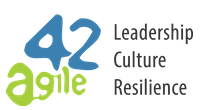5 Signs of a Toxic Organizational Culture and How to Fix it
Organizational culture is so much more than a value statement on your website; it’s the sum of the experiences and beliefs of the people involved. It can be measured through living manifestations, such as rituals, stories of success and failure, habits, and unwritten rules. It is your experience as an employee, and it dictates how you feel about your company and your work. A bad company culture can affect the whole organization and get in the way of sustainable change, growth, and innovation.
Organizational culture can’t be designed or changed, but it can be measured and influenced. Find out how in our Webinar on Shaping Company Culture.
According to a 2022 survey conducted by FlexJobs, toxic company culture is the number one reason people are leaving their jobs. Organizational culture can encompass many different things, so it can be hard to pinpoint where your company is going wrong. In fact, the 2022 State of Agile Coaching Report by Scrum Alliance states that changing an organization’s culture was reported as one of the top challenges.
While it can be hard to put your finger on your organization’s culture, here are some tell-tale signs that you may have problems in this area. Plus, how to resolve them.
Five red flags that indicate you have a toxic culture
- Teams aren’t trusted to make decisions
- Leaders have a fixed leadership style
- The team lacks purpose and direction
- The team seems scared to fail
- People feel burned out
Let’s dive a little deeper into each of these signs of a bad company culture.
Red flag 1: Teams aren’t trusted to make decisions
Many companies advocate for transparency and trust, but these concepts are often embraced in theory without being encouraged in practice. Management teams that don’t allow for autonomy and decision-making can leave people feeling stifled. As a result, the quality of work will suffer and teams may have negative feelings about management styles or a particular manager.
A lack of trust can also lead to a culture of hierarchy. Hiereachal corporate culture is based on clearly defined levels, which depend on rules and a top-down level of control. In today’s fast-paced, unpredictable workplace, we need new ways of working. Hierarchical management is not suited to a fast-changing environment that requires fast decision-making.

Photo by Susanne Jutzeler, suju-foto on Pexels
Faster delivery requires more agile ways of working. This means that people closer to the problems need to be trusted to make decisions and make them quickly. People should be able to self-organize, which requires the support of their work environment and leaders. This approach not only helps organizations thrive, but it helps employees feel trusted, which in turn helps them feel more positive about their organization and more connected to their teams.
How to spot it: A common sign of this problem is frequent bottlenecks or team members’ appearing reluctant to take ownership of projects.
How to fix it: Educate the team and leaders about what self-organization is and give people the trust and support they need to do a great job.
Recommended eLearning Course: Self-organization
Red flag 2: Leaders have a fixed leadership style
Agile leadership requires us to make sense of a situation before we respond, so that our behaviors are coherent with the group of people we are leading and their specific context. So, leaders need to understand the existing context and culture. If leaders fail to do this, it can leave the team feeling frustrated and distrustful.
Even if a specific leadership behavior seems appropriate for a situation, it needs to fit the cultural expectations of the people involved. If it does not, it will very likely cause a negative emotional response and potentially increase motivational debt. In some cases, the impact can be so severe that people decide to leave. This could be seen during the “Great Resignation.” This is a great example of what can happen at the extremes of incoherent leadership.
Coherent leadership is so important, especially as people are more aware of their needs, wants, and expectations in the workplace. Companies can no longer get away with toxic work cultures that don’t value their employees’ happiness. This means that leaders have an important role in cultivating supportive environments.
How to spot it: You will notice that teams are unsure of how to organize around tasks, what the next steps are, or what is expected of them.
How to fix it: Implement and understand Agile leadership. These leaders focus on managing the environment rather than managing people.
Recommended eLearning Course: Agile Leadership Foundations
Red flag 3: The team lacks purpose and direction
To feel driven and motivated in the workplace, we need to be working towards bigger goals. It is crucial that companies communicate these goals and are transparent about them.
Employees should complete their daily tasks and know what is expected of them, but they also should be aware of the bigger picture. This requires communication around strategic goals. The company’s vision needs to filter across the company, not just at the top level. Not only is this exciting for employees, but it also helps them to feel engaged, and more likely to collaborate and work strategically.
How to spot it: Team members are absorbed in their day-to-day tasks and, as a result, no innovation or improvement takes place.
How to fix it: Leaders can help their teams by setting a clear vision, explaining where to go and why, and making sure to continuously give and receive feedback.
Red Flag 4: The team seems scared to fail
Change is scary, and failing is scary, but it is necessary. There can be a lot of money and ego attached to certain projects, which can failing even scarier. Organizations with a healthy company culture try to create “safe to fail” environments. It is not enough to say to people, “You can fail.” Agile leaders know that effective change in a complex environment can only work with an evolutionary approach. They focus on leveraging the potential of the present and the natural predispositions that already exist in a team or an organization, instead of pushing towards an unrealistic ideal state.
It is like parenting. If we want our kids to learn about collaboration, we don’t describe what good collaboration looks like and create a plan for it. Instead, we might encourage them to apply to a football or basketball team or to join a music band. Through these experiences, they will build collaboration “muscles” and learn what collaboration feels like.
Organizations should encourage people to voice their opinions and take on experimental new projects. A side effect of that will almost certainly be failure. If your organization is not encouraging these types of behaviors, then you can’t change, grow, or learn in the process.

Photo by Christian Joudrey on Unsplash
How to spot it: There are very fixed and defined roles within an organization, which do not allow for experimentation to take place.
How to fix it: Allow skilled teams to self-organize and decide how to approach the situation through experimentation. An Agile mindset and approach can help teams achieve this.
Recommended eLearning Course: Agile Foundations
Red flag 5: People feel burned out
If there is a sense of burnout within the team or leadership, it could mean that individual values aren’t aligned with those of your company. This can leave people feeling drained.
One of the biggest causes of this kind of problem is when people are expected to work at an unsustainable pace to meet certain goals or deadlines. While this may get results in the short term, it has far-reaching negative consequences in the long term. Sooner or later, fatigue and anxiety will filter in. Plus, this will negatively affect both the quality of work and work-life balance, which has a massive impact on how people feel about their workplace.

Photo by Nubelson Fernandes on Unsplash
How to spot it: A common sign of burnout is when teams are constantly starting work but not always finishing it. Middle management, teams, and individuals are 100% busy, but delivery is slowing down.
How to fix it: Learn to identify and eliminate impediments to the flow of work in order to keep queued work manageable and alleviate pressure on teams.
The Next Steps to Improving Your Company Culture
There are many ways that companies can improve their culture. But before organizations embark on this journey, they need to know exactly where they are going wrong and what people are saying about their company culture. In our decades of working with organizations, we’ve seen countless hours wasted by not getting to the root of the problem.
Our Organizational Scan™ tool is a scientific, data-based way to measure company culture and take action based on facts, rather than assumptions.
It gives an accurate, real-time view of your organizational culture, leadership style, decision-making capabilities, and employee happiness. This empowers you and your organization to make positive, sustainable changes.








